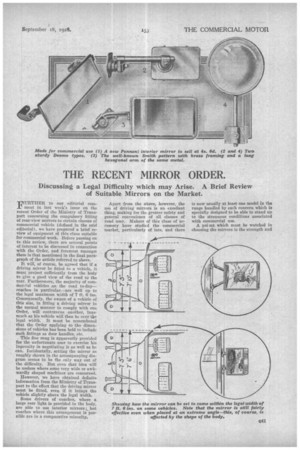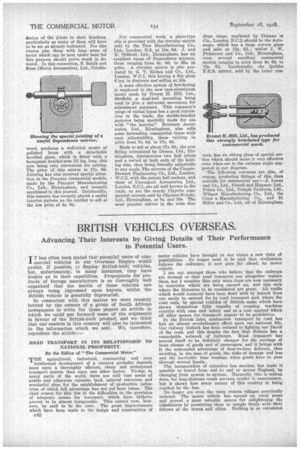THE RECENT MIRROR ORDER.
Page 25

Page 26

If you've noticed an error in this article please click here to report it so we can fix it.
Discussing a Legal Difficulty which may Arise. A Brief Review of Suitable Mirrors on the Market.
FTTRTHER to our editorial comment in last week's issue on the recent Order of the Ministry of Transport concerning the compulsory fitting of rear-view mirrors to certain classes of commercial vehicle (defined in the said editorial), we have prepared a brief review of equipment of this class suitable for commercial work. Before passing on to this review, there are several points of interest to be discussed in connection with the Order, and foremost amongst them is that mentioned in the final paragraph of the article referred to above.
It will, of course, be agreed that if a driving mirror be fitted to a vehicle, it must project sufficiently from the body to give a good view of the road to the rear. Furthermore, the majority of commercial vehicles on the road to-daycoaches in particular—are well up to the legal maximum width of 7 ft. 6 ins. Consequently, the owner of a vehicle of this size, in fitting a driving mirror in the normal manner to comply with one Order, will contravene another, inasmuch as his vehicle will then be over the legal width. It must be remembered that the Order applying to the dimensions of vehicles has been held to include such fittings as door handles, etc.
. This fine snag is apparently provided for the unfortunate user to exercise his ingenuity in negotiating it as well as he can. Incidentally, getting the mirror as roughly shown in the accompanying diagram seems to be the only way out of the difficulty. But even that idea will be useless where some very wide or awkwardly shaped machines are concerned.
However, we have obtained definite Information from the Ministry of Transport to the effect that the driving mirror must be fitted, even if it brings the vehicle slightly above the legal width.
Some drivers of coaches, where a large rear light is provided in the body, are able to use interior mirrors but coaches where this arrangement is possible are in a comparative minority.
Apart from the above, however, the use of driving mirrors is an excellent thing, making for the greater safety and general convenience of all classes of road user. Makers of this class of accessory have studied the commercial market, particularly of late, and there
is now usually at least one model in the range handled by each concern which is specially designed to be able to stand up to the strenuous conditions associated with commercial use.
A poimit which must be watched in choosing the mirrors is the strength and design of the joints in their brackets, particularly as many of them will have to be set as already indicated. For this reason also those with long arms of metal which can be bent under heat for this purpose should prove much in demand. In this connection, S. Smith and eons (Motor Accessories), Ltd., Crickle wood, produces a well-tried model of polished brass with a detachable bevelled glass, which is fitted with a hexagonal bracket-arm 12 ins, long, this arm being very convenient for setting. The price of this mirror is 17s. 6d. Jointing has also received special attention in the Pennant commercial models, made by the Pennant Manufacturing Co., Ltd., Birmingham, and recently mentioned in this journal. Incidentally, this concern has recently placed a useful interior pattern on the market to sell at the low price of 4s. 6d. For commercial work, a plate-type clip is provided with the circular mirror sold by the Taw Manufacturing Co., Ltd., London, N.8, at 10s. 6d. J. and R. Oldfield, Ltd., Birmingham, has an excellent range of Dependence mirrors, these ranging from 8s. 6d. to 25s. in price. A. circular mirror is also pro. duced by G. T. Riches and Co., Ltd., London; W.C.1, this having a flat glass 6 ins, in diameter and selling at 10s.
A most effective system of bracketing is employed in the new cast-aluminium model made by Ernest H. Hill, Ltd., Sheffield, -a dual-ball mounting being used to give a universal movement for adjustment purposes. This company's range of varied types has a good reputation in the trade, the double-bracket patterns being specially made for use with "the heavies." Eversure Accessories, Ltd., Birmingham, also sells some interesting commercial types with easy adjustability, these varying in price from 7s. 6d. to 17s. 6d.
Made to sell at about 17s. (3d., the new fitting introduced by Desmo, Ltd., Birmingham, incorporates two ball joints and a swivel at both ends of the holding arm, thus being literally adjustable to any angle. The mirrors of the CooperStewart Engineering Co., Ltd., London, W.C.2, with the patent ball sockets, and those of Davenport Accessories, Ltd., London, E.C.1, are all well known in the trade, as are the sturdy Clayrite commercial mirrors sold by Clayton-Wright, Ltd., Birmingham, at Ss. and 109. The most popular mirror in the wide Sta
dium range, marketed by Etienne et Cie., London, E.C.2, should be the Autoscope, which has a large convex glass and sells at 12s. 6d.; whilst J. W. Pickavant and Co., Ltd., Birmingham, runs several excellent commercial models ranging in price from 4s. 6d. to 12s. 6d. Incidentally, the Quikko F.R.S. mirror, sold by the latter con.
cern, has an oblong glass of special section which should make it very effective even when set to the extreme angle suggested in our diagram.
The following concerns are also, of course, producing fittings of this class suitable for commercial use Lucas and Co., Ltd., Powell and Hanmer, Ltd., Prima Co., Ltd., Temple Products, Ltd., Wilmot Manufacturing Co., Ltd., the Crow n Manufacturing Co.„ and EL Miller and Co., Ltd., all of Birmingham.
































